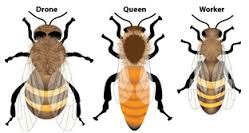In the autumn a colony has 10,000-15,000 worker bees and a queen. The workers do not fly anymore, and form a dense cluster around the queen. By their feeding the outer bees and their gradual displacement inwards, a temperature of 12-20°C at the center remains maintained. A true hibernation is no question. The faeces are heaped in the very stretchy rectum. Increases in winter the outside warm to above 8°C, then the worker bees fly out to relieve themselves (cleaning flight). Winter calm lasts until late January. Then only the queen begins again to lay eggs. (Male) drones come from the unfertilized eggs. The old bee population dies gradually in spring, but there are so many young bees born that the population is increasing.
Each bee has a specific task.
 A queen can be 3 to 5 years. She flies only to be fertilized or to swarm to establish a new colony.
A queen can be 3 to 5 years. She flies only to be fertilized or to swarm to establish a new colony.
After building a new home with combs the brand new queen makes a nuptial flight. The drones haunt her. The fastest 10 to 20 drones mate with her. After mating the drone dies. Two to three days later, the queen must lay eggs for the rest of her whole life. The Queen can lay up to 2,000 eggs per day during the high season. That is double its own weight.
If the queen wants to lay eggs she first checks whether the cell is clean and just big enough. Then she puts her abdomen into the cell and she puts an elongated egg. Depending on the food a worker or a queen will be formed.
After three days, the eggs become larvae.
After six days, the cells get wax caps and the larva turns into a pupa.
A Queen comes out after seven days.
A worker comes after twelve days. From the shape of the lid you can see what is inside. For drones that are larger than the workers the lid is very sphere. The cells of a queen are bigger anyway. On those peanut shaped cells is a queens lid, which is a much larger cap, like with a proboscis.
A drone lives for several months. They are just born to fertilize the queen. Then they die or are slaughtered by the worker bees (drones slaughter: expelled and tossed out). Therefore, in the winter there are no drones in the colony.
The larva where a worker comes from will get the first three days royal jelly. Then she gets bee bread: a mash of nectar and pollen. This food is of lower quality and therefore the worker develops less. Their reproductive organs are much less developed so they can not lay eggs.
After her birth, she begins to wash her selves and clean cells.
After two days cleaning, they start on day three feeding the older larvae.
Then they can from day 6 feeding younger larvae and put pollen and nectar in the food cells.
From day 13, they may sweat wax and build honeycombs.
On day eighteen she is responsible for the security of the home.
After two days guarding, they must from day 21 on collect nectar, pollen, propolis and water.
She makes about 10 flights of 15 minutes a day. The worker can reach 21 to 24 km per hour and visits to 150 flowers per flight. They can carry up to 40 to 50 mg pollen. This is very much because the creature itself weighs only 100 mg.
After 42 days, they usually die of exhaustion.
In winter the queen don’t lays eggs and there are other jobs. The workers must put the drones outside, shut and seal the hive and warm the queen.
